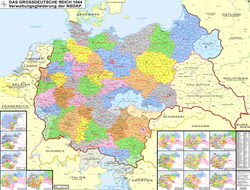Gau München-Oberbayern
| Gau Munich–Upper Bavaria | ||||||
| Gau of Nazi Germany | ||||||
|
||||||
|
||||||
|
Map of Nazi Germany showing its administrative subdivisions (Gaue and Reichsgaue). |
||||||
| Capital | Munich | |||||
| Gauleiter | ||||||
| • | 1933–1944 | Adolf Wagner | ||||
| • | 1944–1945 | Paul Giesler | ||||
| History | ||||||
| • | Establishment | 30 January 1933 | ||||
| • | Disestablishment | 8 May 1945 | ||||
| Population | ||||||
| • | 17 May 1939 | 1,999,048 | ||||
The Gau Munich–Upper Bavaria (German: Gau München–Oberbayern) was an administrative division of Nazi Germany in Upper Bavaria from 1933 to 1945. From 1926 to 1933, it was the regional subdivision of the Nazi Party in that area.
The Nazi Gau (plural Gaue) system was originally established in a party conference on 22 May 1926, in order to improve administration of the party structure. In the early stages, the borders and leaders of these Gaue fluctuated frequently, mainly due to internal power struggles. The Gau Munich-Upper Bavaria was, for the most part, identical with today's Regierungsbezirk Upper Bavaria, of which Munich is the capital.
The Gau Munich-Upper Bavaria came under the leadership of Adolf Wagner on 1 November 1929, when the Gau system in Bavaria was formalised, and remained under his control until his death in 1944. The Gau was actually a merger of the previously separate Gaue Munich and Upper Bavaria. Until 1930, Bavaria, as the heartland of the Nazi movement in the 1920s, was seen by Hitler as his personal realm, the local Gaue commonly being called Untergaue (English:Sub-Gaue), to show their dependence on the head of the party. Only when Hitler's ambitions turned national did his interest in Bavarian affairs dwindle. With the end of the internal power struggle, the following six Gaue had been established in Bavaria:
Within those and the other Nazi German Gaue, Munich-Upper Bavaria claimed an elevated position for itself. The reason for this being, that Munich was the birthplace of "the movement" (German:Hauptstadt der Bewegung - a title it officially carried). The Gaue called itself Traditionsgau München-Oberbayern to cement this elevated position.
With the ascent of the Nazis to power on 30 January 1933, the so-called Machtergreifung, the party immediately began to disassemble the power of the German states, the Länder. It was envisioned by the Nazis that the Party-Gaue would take the place of the old structure. In reality, Hitler was afraid of such a move, fearing it would upset local party leaders and could possibly result in an inner-party power struggle.
...
Wikipedia



